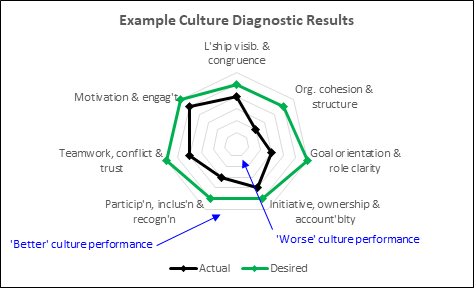How to Measure Your Organisation's Culture 'Performance'
How’s the teamwork in your organisation?
Are staff motivated?
How effective Is leadership?
And, if you have answers to these questions, how do you know the answers?
Culture is as we have seen, a hot topic these days, with far greater recognition of 'the whole universe of fuzzy people issues that increasingly determine the success or failure of efforts to implement otherwise flawless technical solutions’ (to borrow Robert Levasseur's phrase).
In short, culture shapes results. The state of an organisation’s culture precedes and influences the performance capability of that organisation.
We’ve also seen that culture problems are often many-headed beasts: staff conflict might be the result of staff not taking ownership for their work … as well as the cause of poor staff motivation.
To deal effectively with organisational culture then, it has to be properly analysed and put on a firm evidential basis so the appropriate strategy can be put in place. There’s no point trying to resolve a situation of staff conflict by providing training in conflict resolution if the underlying problem, in fact, is the absence of clear priorities or lack of clarity about roles and functions.
The question then is: how do you diagnose the culture in a division or organisation?
Introducing the Culture Diagnostic
Help is at hand. I have developed the Culture Diagnostic – a survey-based instrument which provides scores on seven dimensions of organisational culture:
• Leadership visibility and congruence with organisational values
• Organisational cohesion and structure
• Goal orientation and role clarity
• Initiative, ownership and accountability
• Participation, inclusion and recognition
• Teamwork, conflict and trust, and
• Motivation and engagement.
The Culture Diagnostic is comprised of 50 statements, each reflecting one of the seven aspects of the division or organisation’s culture above (leadership visibility etc.). Example statements include ‘It’s difficult to assign work here without making waves’ and ‘People take pride in their work’. Respondents evaluate each of the 50 questions on a six-point scale in terms of whether the statement applies always, usually, often, sometimes, rarely or never.
The survey results allow us to see which of the aspects of culture are the best or worst performing areas: how does goal-orientation stack up against teamwork? Is our organisational cohesion the issue, or is it the level of initiative and accountability taken by staff? We can compare results across the seven dimensions to identify where are the problem areas, and which areas are in hand.
Users of the Culture Diagnostic not only evaluate actual aspects of culture as they are now however; they also indicate what they believe the situation should be (the desired or ideal state).
This allows us to see whether any particular aspect of culture (say, leadership visibility) is seen by people as inherently more desirable than any other. It also allows us to see – for each aspect – where the gap between actual and ideal culture is smallest or greatest. Obviously, the bigger the gap between actual and ideal ratings for a particular item, the greater the concern: these areas would be the first areas for action by management. Thus the gap between ideal and actual performance provides further valuable information to compare against the simple ratings of actual culture.
Following the administering of the survey to respondents, I take the results, aggregate and analyse them to produce a diagram resembling the one below; scores towards the outer edge of the diagram show more positive culture and are more desirable, while those closer to the centre have lower scores and hence reflect a worse culture performance.

In the above (hypothetical) example the organisation is in good shape in terms of staff motivation, leadership visibility and congruence, and staff initiative ownership and accountability, as shown by the actual scores (in black) which are closer to the outside of the graph and for which the gap between the black and green scores is the smallest.
On the other hand, the scores for actual culture performance are lowest for organisational cohesion and structure, goal orientation and role clarity, and participation inclusion and recognition: these aspects of culture not only have the lowest actual scores (the scores coloured black are closest to the centre) – they also have the largest gaps between actual and desired scores (ie. the biggest distance between the black and green scores).
A Culture Improvement ‘Toolkit’
This organisation would do well to ‘dig into’ the scores to find out what was pulling the latter scores down, and then develop a customised ‘package’ of strategies to deal with the core issues, in this case the organisation might look at strategic planning to provide goal clarity; process mapping and consequent development of policies and procedures to address the issues of organisational cohesion; and establishing some collaborative problem solving and performance review to provide mechanisms for staff contribution. They may also look to draw on their culture strengths (especially in respect of leadership visibility and staff initiative) to bolster performance in the under-performing areas.
(Click here for a more complete sketching out of possible interventions for various types of culture issues).
So, the Culture Diagnostic provides an empirical basis for ‘pinning down’ organisational culture at a point in time and making it tractable. In combination with a set of aligned culture improvement interventions, we now have a holistic, evidence-based and programmed approach to identifying, diagnosing and fixing an organisation’s culture.
Not bad.
Putting a Value on Improved Culture Performance
How much is it worth to have a clear sense of organisational direction and an agreed set of priorities?
What’s the value associated with having more highly motivated staff?
What is the return on the investment of helping a unit function more like a team and less like a committee?
These things are, of course, notoriously difficult to quantify, but with some thought and small-scale data collection and analysis, we can shed significant light. Even units that serve functions internal to an organisation (such as IT, HR and Finance) and on-budget Government departments have outputs and performance measures (eg. number of calls taken, turnaround time for recruitment, number of Ministerials finalised, number of invoice processing errors, customer satisfaction) and therefore correlations can be calculated between these and improvements in culture. [nb. I think this is the next port-of-call for organisational culture research and investigation…]
The results of that analysis would enable a manager to say, for example, that a three percent increase in reported Teamwork, Conflict & Trust in the Culture Diagnostic was associated with a five percent boost to customer satisfaction which was in turn associated with a two-and-a-half percent boost in revenue (these figures are illustrative only). That boost to revenue might amount to an extra half a million dollars (say) which would likely exceed the cost of the culture improvement intervention by many orders of magnitude. The whole scenario would look something like the below:

The beauty of this is that it not only takes the identification of culture issues out of the realm of soft and fuzzy supposition, it also links aspects of culture to bottom-line business results and does so in an empirically-based manner. At the same time, it highlights the implicit costs of leaving culture problems unaddressed.
It’s hard to argue with that.
* Special Offer *
The Culture Diagnostic is a new instrument which I have recently developed: I am looking to beta-test it with the results forming the input into further analysis for the statistical validation of the instrument.
If you would like to be one of the first to use this newly developed management tool to diagnose the culture in your organisation, do so at a reduced rate, and put your organisation on the pathway to the higher cultural and business performance discussed here, please contact me at info@mcarmanconsulting.com or on phone 0414 383 374.
To give an idea of pricing: I am offering to administer, analyse and present the findings from the Culture Diagnostic for 50 respondents at a GST-inclusive price of $8,800-. This offer will expire at midday (Sydney time) on Friday 5 October 2018.
I look forward to working with you to use the Culture Diagnostic to define and improve the soft, culture aspects of your organisation … and lay the basis for enhancements to ‘hard’ business results.
Warm regards,
Michael
© Michael Carman 2018

